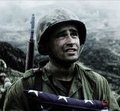Warfare1
Posts: 658
Joined: 10/20/2004
Status: offline

|
quote:
ORIGINAL: SMK-at-work
quote:
ORIGINAL: Warfare1
quote:
ORIGINAL: SMK-at-work
We've done the Siberians to death already - not only were they not used en masse but they were not combat veterans - the standard conscription was for 2 years, and it was more than 2 years since hte R-J war of 1939 - those soldiers released to reserve units sicne them were called up into whatever recruited them locally - ie they were dispersed around the rest of the army.
SMK-at-work:
You seem to persist with these statements, and yet you have not provided a single quote and page number from a book by a recognized historian on the subject.
1/ there's nothing "seem to persist" about it - I DO persist in making these statements.
2/ As I said in another thread - I shall await the return of my tomes on the subject, and let yo have it :)
Hi :)
On a wargame forum you should always be prepared to provide sources when announcing NEW historical information.
Let me help you out a bit.
No historian I have read has ever used the term "Siberian Hordes". This is your term. There was never a mass of Siberians. Most authorities I have read indicate that between 15 to 20 divisions from the east were sent to the west between Oct/41 and Jan/42.
There were about 100 Soviet divisions in total being used in the counter attack around Moscow in Dec 1941. Of these, 80 divisions were worn out and were drawn in from other fronts. They were grouped on the German flanks. This was the "ANVIL".
The almost 20 Siberian divisions, on the other hand, were rested, were almost fully equipped and at full strength, and were located north of Moscow, and were to be used at the last minute as the "HAMMER BLOW" striking the "ANVIL".
You mentioned previously about the Siberian "Myth". Yet, Siberian divisions were sent west. All established authorities recognize this.
You also stated that these Siberian divisions were inexperienced and had been disbanded. Yet historians state otherwise.
Alan Clark, in his book "Barbarossa" states on page 171, "Yet by itself the impact of the winter would not be enough for an exhausted and outnumbered Red Army to turn the tables on its adversary; the chosen instrument for this task was the agglomeration of hard, long-service divisions from the Siberian Command. In order that the impact of the Siberian troops take maximum effect, it was vital that they be held back until the last moment...."
For those who have Clark's book, he provides a map on page 173 indicating where all these divisions were located.
Clark, an historian, mentions that the Siberian divisions had been in LONG service, and were experienced. Why would he say that? In 1939, the Soviets fought a battle with Japan, in which Japan suffered 50,000 casualties.
Between that time and late 1941 Hitler took great pains to get Japan to attack NORTH into Siberia. Stalin simply could not disband these Siberian troops in the east. The Japanese threat was always there.
It was not until late 1941 when Stalin's spy Richard Sorge indicated that the Japanese had decided to attack SOUTH, that Stalin released about 20 of these Siberian divisions to move west around Moscow.
In sum, about 20 experienced, mostly full-strength Siberian divisions were sent west AFTER it was realized that Japan would not attack Siberia. They proved to be instrumental in the counterattack around Moscow.
The other 80 Soviet divisions were mostly exhausted, and worn out from months of bitter fighting. They were to be used against the German forces until the last minute when the fresh Siberian troops would be released.
< Message edited by Warfare1 -- 7/11/2007 7:02:51 AM >
|
 Printable Version
Printable Version


















 New Messages
New Messages No New Messages
No New Messages Hot Topic w/ New Messages
Hot Topic w/ New Messages Hot Topic w/o New Messages
Hot Topic w/o New Messages Locked w/ New Messages
Locked w/ New Messages Locked w/o New Messages
Locked w/o New Messages Post New Thread
Post New Thread